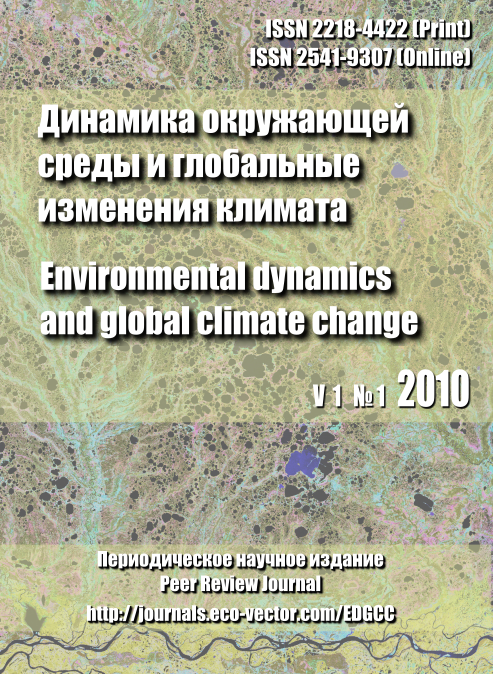Budget chemical elements in bog ecosystems middle taiga Western Siberia
- Authors: Kosykh N.P.1, Mironycheva-Tokareva N.P.1, Parshina E.K.1
-
Affiliations:
- Институт почвоведения и агрохимии СО РАН
- Issue: Vol 1, No 1 (2010)
- Pages: 85-95
- Section: Articles
- URL: https://edgccjournal.org/EDGCC/article/view/6456
- DOI: https://doi.org/10.17816/edgcc1185-95
- ID: 6456
Cite item
Full Text
Abstract
Feature of the biological cycle of chemical elements in wetland ecosystems is prolonged accumulation of chemical elements in peats. For this reason the total biomass on the unit square active layer (up to 30 cm from the surface of mosses) in the bog in 5 times more phytomass. Slow motion mass in biological cycles in wetland ecosystems the bulk of biomass to 80% is in peat. Territory of Western Siberia reaches 24% and in some areas in the peatlands area exceeds 70%, so the relevant study of the biological cycle of chemical elements in this part of the Earth's surface. Study the functional characteristics of wetland ecosystems and their quantification is scientific interest and allows you to contribute to the study of chemical elements and their change in various biological processes. Evaluation of chemical elements in production, destruction processes in the process of deposit and resinteza organic compounds, which are the basis of biotic cycling can sustainability bog ecosystems to climate change today. The purpose of this work is to define the quantification of chemical elements in production-destruction processes, taking into account the process resinteza bog Middle Taiga Western Siberia depending on the type of the ecosystem. Based on experimental data made the calculation of budget chemical elements in ecosystems Middle Taiga Western Siberia. Are stocks of chemical elements in living phytomass and mortmass, in production and destruction and process of resintes. The degree of difference in element concentrations in the phytomass is high for different types of ecosystems. However, the stocks of elements are determined to the larger degree by the value of phytomass and they increase in a series of ecosystems: oligotrophic hollow → ridge → mesotrophic hollow → ryam. Iinventory of items in the wetland ecosystems is 2 - 4 times when moving from phytomass in mortmass. Consumption of chemical elements increases with increasing net primary production. Listed items with dependency loss of production, with the increase in production losses are increasing, decreasing the concentration. In the process of retronslocation 5-22% N, 6-15% P, and 25-36 % K of consumption is returned in the ecosystem. All selected features depend on the type of the ecosystem, species community and chemical composition of plants.
About the authors
Natal'ya Pavlovna Kosykh
Институт почвоведения и агрохимии СО РАН
Author for correspondence.
Email: kosykh@issa.nsc.ru
Институт почвоведения и агрохимии СО РАН
Nina Petrovna Mironycheva-Tokareva
Институт почвоведения и агрохимии СО РАН
Email: nina@issa.nsc.ru
Институт почвоведения и агрохимии СО РАН
Evgeniya Konstantinovna Parshina
Институт почвоведения и агрохимии СО РАН
Email: zhenya1579@rambler.ru
Институт почвоведения и агрохимии СО РАН
References
- Базилевич Н.И., Титлянова А.А. 2008. Биотический круговорот на пяти континентах: азот и зольные элементы в природных наземных экосистемах. Новосибирск: Изд-во СО РАН.
- Козловская Л.С., Медведева В.М., Пьявченко Н.И. 1978. Динамика органического вещества в процессе торфообразования. Л.: Наука.
- Манаков К.Н. 1972. Продуктивность и биологический круговорот в тундровых биогеоценозах Кольского полуострова. Л.:Наука. 147 с.
- Наумов А.В., Косых Н.П., Миронычева-Токарева Н.П., Паршина Е.К. 2007. Углеродный баланс в болотных экосистемах Западной Сибири // Сибирский экологический журнал. № 5. С. 771 -779.
- Ремезов Н.П. 1962. Динамика взаимодействия широколиственного леса с почвой // Проблемы почвоведения. М.Изд-во АН СССР. С.101-147.
- Романова Е.А. 1974. Типы болотных массивов и закономерное распределение их на территории Западной Сибири // Типы болот СССР и принципы их классификации. Л.: Наука. C. 167-174.
- Титлянова А.А. 1979. Биологический круговорот азота и зольных элементов в травяных биогеоценозах. Новосибирск: Наука.
- Kosykh N.P., Mironycheva-Tokareva N.P., Peregon A.M., Parshina E.K. 2008. Net primary production in peatlands of middle taiga region in western Siberia // Russian Journal of Ecology. V.39. № 7. Р.466-474.
- Peregon A., Maksyutov S., Kosykh N., Mironysheva-Tokareva N. 2008. Map based inventory of the wetland biomass and NPP in western Siberia // J. Geophys. Res. V. 113, G01007, doi: 10.1029/2007JG000441.
Supplementary files










